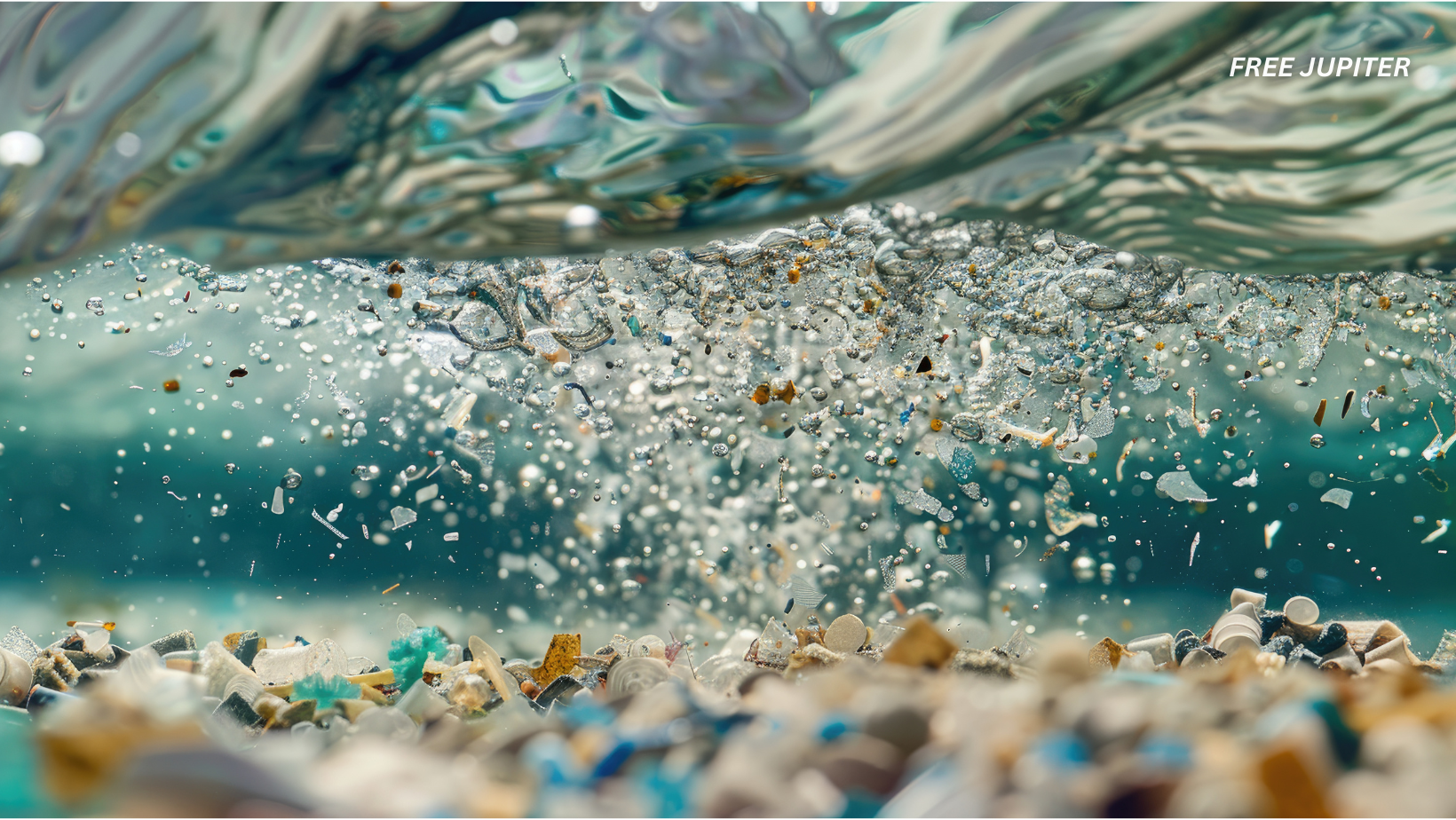Friendly Note: FreeJupiter.com shares general info for curious minds 🌟 Please fact-check all claims—and always check health matters with a professional 💙
Plastic is everywhere. It wraps our food, lines our clothes, and even floats invisibly through the air we breathe. But some of the most concerning plastic pollution isn’t the kind we can see—it’s the microscopic fragments drifting through rivers, lakes, oceans, and yes, even your tap water. These tiny bits are called microplastics, and they’ve become a growing global concern.
Now, in a refreshingly low-tech twist, scientists have found a surprising pair of allies in the fight against this invisible threat: okra and fenugreek.
What’s the Big Deal With Microplastics?
Microplastics are pieces of plastic less than 5 millimeters in length. They come from broken-down plastic waste, microbeads in cosmetics, fibers from synthetic clothes, and degraded packaging. They’re practically impossible to remove once they enter the water cycle—and they don’t just float aimlessly. These particles can absorb harmful chemicals, enter the food chain, and potentially wreak havoc on ecosystems and human health.
Scientists have found microplastics everywhere—from deep-sea trenches to Arctic snow, and even inside human lungs and placentas. As research continues to uncover how these particles interact with our bodies, it’s become clear that finding a way to filter them out of our water is more than just a feel-good environmental fix—it’s a health necessity.
The Gooey Heroes: What Makes Okra and Fenugreek Special?
Both okra and fenugreek are common kitchen staples in many parts of the world, known for their sticky or mucilaginous textures. That slimy substance isn’t just a cooking quirk—it’s made up of polysaccharides, long-chain natural sugars that act like a kind of organic glue. And as it turns out, this natural stickiness is excellent at trapping plastic particles.
In their study, a research team led by Rajani Srinivasan at Tarleton State University explored how the slime factor from these plants could be turned into a functional, eco-friendly tool for cleaning water. Their results were published in ACS Omega, a journal of the American Chemical Society.
The method was surprisingly straightforward:
- Soak and blend – The team sliced up okra pods and soaked them in water. Fenugreek seeds were blended into a solution. These were left overnight.
- Dry and powder – After extracting the goo, the liquid was dried into a fine powder.
- Test the magic – The powders were then mixed into water samples spiked with microplastics.
Read more: Scientists Say Cancer Can Now Be Detected Years in Advance with Simple Blood Test
The Results? Surprisingly Powerful
In a controlled lab setting using clean water filled with microplastics, researchers tested how well each plant powder could trap and remove the plastic bits. Here’s what they found:
- Okra alone removed about 67% of the plastic particles in one hour.
- Fenugreek alone blew past that, trapping 93% in the same time.
- A 50/50 blend of both reached its peak performance of 70% removal in just 30 minutes.
That’s not just decent—that’s impressive. Especially considering these powders beat out polyacrylamide, the synthetic polymer widely used in modern wastewater treatment plants. Polyacrylamide does the job, but it’s not without drawbacks—it’s derived from petroleum, it doesn’t break down easily, and in certain forms, it can even release harmful byproducts. That’s why a biodegradable, non-toxic alternative like okra or fenugreek is getting scientists excited.
Real Water, Real Challenges
Of course, what works in clean lab water doesn’t always work in real-world conditions. So the team took it a step further.
They collected water samples from across Texas—rivers, lakes, groundwater sources, and even the Gulf of Mexico. These samples came pre-loaded with an unpredictable mix of microplastics—different shapes, sizes, and chemical properties.
Even so, the plant powders still performed well:
- In ocean water, okra was the champ, removing up to 80% of the plastics.
- In groundwater, fenugreek led the way with 80–90% effectiveness.
- In freshwater, the equal mix of both powders was the most balanced performer, removing around 77%.
Why the variation? Different water sources have different chemical makeups—some are saltier, others more acidic, and the plastics themselves differ in how slippery or sticky they are. Each factor influences how well the plant polymers can do their job.
A Sustainable Solution With Real Potential
Let’s take a moment to appreciate the beauty of this idea. This isn’t a flashy gadget. It doesn’t involve expensive infrastructure or patented tech that only a few countries can afford. It’s simple. It’s natural. And it’s already part of daily life in much of the world.
That makes it especially promising for rural or developing regions, where access to clean water can be inconsistent and modern water treatment systems are hard to come by. If okra and fenugreek powders can be used in localized or small-scale filtration efforts, they could offer a low-cost way to reduce microplastic contamination where it matters most.
Another plus? These plants are biodegradable and renewable. If widely adopted, they could cut down on the need for harsh synthetic chemicals that linger in the environment or pose long-term health risks.
Read more: Scientists Reveal What That Pleasant Smell Really Is After It Rains
What’s Next?
While the lab results are promising, scientists still need to test this process at larger scales. Can it be adapted for municipal water systems? Can it be turned into a reusable filter or incorporated into everyday water pitchers? And what about cost—can farmers grow enough okra and fenugreek to meet potential demand?
Srinivasan and her team are optimistic. They’re continuing to test the plant extracts under different real-world scenarios and are working on ways to refine the extraction process for maximum efficiency. If things go well, the technology could scale up—without scaling up environmental harm.
Nature Has Always Been Ahead of Us
This study is part of a larger movement that’s taking cues from the natural world to solve human-made problems. From mushrooms that digest plastic to seaweed that mops up oil spills, nature’s toolkit is vast—and often more elegant than anything we’ve engineered.
It’s a timely reminder: sometimes, the answers we’re looking for aren’t found in a lab filled with chrome and lasers. They’re growing quietly in our gardens and spice racks, waiting for us to notice.
🍌 Why Banana Peels Might Save the Day: The Surprisingly Clever Way Fruit Waste Can Purify Water
You probably don’t think twice about tossing a banana peel into the compost—or worse, the trash. But that humble yellow wrapper could actually play a role in solving one of the world’s dirtiest problems: contaminated water.
Turns out, banana peels are more than just slippery hazards in cartoon gags. Scientists have discovered that they’re rich in compounds that can help pull heavy metals and other toxic substances out of polluted water. Yes, really.
Peel Science: What’s Going On Inside That Banana Skin?
Banana peels are packed with lignin, pectin, and cellulose—fancy words for natural fibrous materials that have an amazing knack for attracting and bonding with metal ions and pollutants. These fibrous structures are porous, meaning they have lots of little holes and surfaces where nasty stuff like lead, copper, cadmium, and even mercury can stick.
It works a bit like a magnet. When ground-up banana peels are added to contaminated water, their natural compounds act like sponges, soaking up heavy metals and trapping them in the plant fibers. After a little time, the water can be filtered, leaving behind a significantly cleaner sample and a peel full of toxins—ready for safe disposal.
Read more: Stretch From Earth to Pluto And Back 17 Times!
Lab-Tested—and It Works
Researchers in Brazil first brought this concept to attention by drying banana peels, grinding them into powder, and mixing them into contaminated river water. The results were impressive. The peel particles soaked up heavy metals quickly and without needing any fancy equipment.
Some studies even found that banana peels removed up to 65%–80% of certain metals in just a few minutes, making them a cost-effective and low-tech solution for areas where clean water is hard to come by.
Disclaimer: The information in this article is for general informational purposes only and is not medical advice. We are not doctors, and this website is run as a family hobby project. Always consult a qualified healthcare professional before making decisions about your health. Please fact-check any claims and use this content as a starting point, not a substitute for professional guidance.










